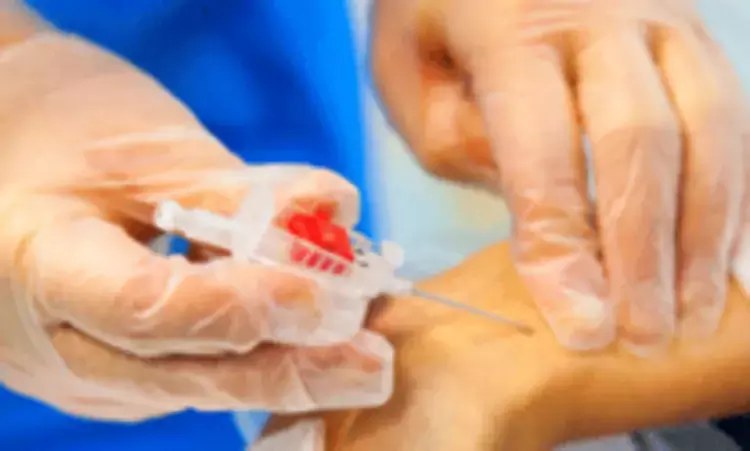- Home
- Medical news & Guidelines
- Anesthesiology
- Cardiology and CTVS
- Critical Care
- Dentistry
- Dermatology
- Diabetes and Endocrinology
- ENT
- Gastroenterology
- Medicine
- Nephrology
- Neurology
- Obstretics-Gynaecology
- Oncology
- Ophthalmology
- Orthopaedics
- Pediatrics-Neonatology
- Psychiatry
- Pulmonology
- Radiology
- Surgery
- Urology
- Laboratory Medicine
- Diet
- Nursing
- Paramedical
- Physiotherapy
- Health news
- Fact Check
- Bone Health Fact Check
- Brain Health Fact Check
- Cancer Related Fact Check
- Child Care Fact Check
- Dental and oral health fact check
- Diabetes and metabolic health fact check
- Diet and Nutrition Fact Check
- Eye and ENT Care Fact Check
- Fitness fact check
- Gut health fact check
- Heart health fact check
- Kidney health fact check
- Medical education fact check
- Men's health fact check
- Respiratory fact check
- Skin and hair care fact check
- Vaccine and Immunization fact check
- Women's health fact check
- AYUSH
- State News
- Andaman and Nicobar Islands
- Andhra Pradesh
- Arunachal Pradesh
- Assam
- Bihar
- Chandigarh
- Chattisgarh
- Dadra and Nagar Haveli
- Daman and Diu
- Delhi
- Goa
- Gujarat
- Haryana
- Himachal Pradesh
- Jammu & Kashmir
- Jharkhand
- Karnataka
- Kerala
- Ladakh
- Lakshadweep
- Madhya Pradesh
- Maharashtra
- Manipur
- Meghalaya
- Mizoram
- Nagaland
- Odisha
- Puducherry
- Punjab
- Rajasthan
- Sikkim
- Tamil Nadu
- Telangana
- Tripura
- Uttar Pradesh
- Uttrakhand
- West Bengal
- Medical Education
- Industry
Nitroglycerin Fails to Prevent Radial Artery Occlusion irrespective of time of administration: PATENS Trial

Transradial access (TRA) has grown to become the default access site. However, TRA is not without challenges and complications. TRA is technically more difficult with a longer learning curve and is associated with radial artery spasm and radial artery occlusion (RAO), particularly in females and elderly patients.
A recent study suggests that administration of nitroglycerin upon radial sheath insertion or right before sheath removal was shown not to be associated with a reduction in RAO rates. The study findings were published in the JACC: Cardiovascular Interventions on March 21, 2022.
Maintaining arterial blood flow while achieving hemostasis is probably the most important factor in reducing RAO. While radial artery occlusion was once considered a "unique" phenomenon, there is increasing recognition that it can pose a real challenge for patients and operators. As a result, new research findings coupled with growing experience can help to refine our approach to prevent RAO. To further explore the effect of nitroglycerine on ROA, Dr Roberto L. da Silva and his team conducted a study to evaluate whether administration of nitroglycerin at the beginning or end of a TRA procedure would preserve radial patency.
The researchers conducted a prospective, multicenter, randomized, double-blind, 2-by-2 factorial, placebo-controlled trial (PATENS trial) with 2,040 patients undergoing TRA. They randomized the patients to either 500 μg nitroglycerin or placebo; each arm was also sub-randomized to early (upon sheath insertion) or late (right before sheath removal) nitroglycerin administration to evaluate the superiority of nitroglycerin in the prevention of RAO with 24 hours on Doppler ultrasound.
Key findings of the study:
- Among 2040 patients, the researchers observed that RAO occurred in 49 patients (2.4%). They noted that fifteen of these patients (30.6%) showed reestablishment of flow at 30 days.
- They found that nitroglycerin, compared with placebo, did not reduce the risk for RAO at either of the 2-time points (early, 2.5% vs 2.3%; late, 2.3% vs 2.5%).
- Upon multivariable analysis, they noted that the presence of spasm (OR: 3.53) and access achieved with more than 1 puncture attempt (OR: 2.58) were independent predictors of RAO.
The authors concluded, "The routine use of nitroglycerin was not associated with a reduction in the rate of RAO, regardless of the time of administration (at the beginning or end of the TRA procedure)."
In an accompanying editorial, Dr Ziyad Gazzhal and Omar Chaabo wrote, " It is our view, based on this study, that intra-arterial nitroglycerin is not necessary at the time of sheath removal, provided best practices for the prevention of RAO are followed methodically. However, we believe that the administration of vasodilator therapy is still warranted at the beginning of the transradial procedure to reduce the chance of radial spasm. Finally, the distal radial artery approach at the snuffbox has been associated with a significantly lower incidence of proximal RAO and this technique, which has advantages and limitations, continues to evolve"
For further information:
DOI: https://www.jacc.org/doi/10.1016/j.jcin.2022.02.026
Keywords:
Transradial access, radial artery occlusion, arterial spasms, PATENS trial, Nitroglycerin, Early initiation, Late initiation, Doppler, Transradial Catheterization, JACC: Cardiovascular Interventions.
Medical Dialogues Bureau consists of a team of passionate medical/scientific writers, led by doctors and healthcare researchers. Our team efforts to bring you updated and timely news about the important happenings of the medical and healthcare sector. Our editorial team can be reached at editorial@medicaldialogues.in.
Dr Kamal Kant Kohli-MBBS, DTCD- a chest specialist with more than 30 years of practice and a flair for writing clinical articles, Dr Kamal Kant Kohli joined Medical Dialogues as a Chief Editor of Medical News. Besides writing articles, as an editor, he proofreads and verifies all the medical content published on Medical Dialogues including those coming from journals, studies,medical conferences,guidelines etc. Email: drkohli@medicaldialogues.in. Contact no. 011-43720751


